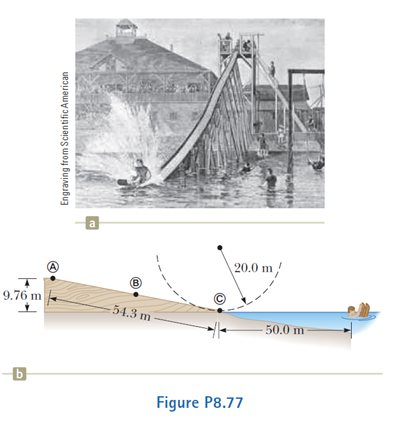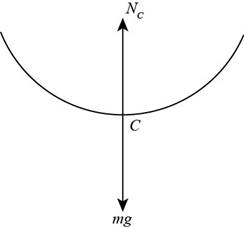
Concept explainers
Review. In 1887 in Bridgeport, Connecticut, C. J. Belknap built the water slide shown in Figure P8.77. A rider on a small sled, of total mass 80.0 kg, pushed off to start at the top of the slide (point Ⓐ) with a speed of 2.50 m/s. The chute was 9.76 m high at the top and 543 m long. Along its length, 72.5 small wheels made friction negligible. Upon leaving the chute horizon-tally at its bottom end (point ©), the rider skimmed across the water of Long Island Sound for as much as 50 m, “skipping along like a flat pebble,” before at last coming to rest and swimming ashore, pulling his sled after him. (a) Find the speed of the sled and rider at point © (b) Model the force of water friction as a constant retarding force acting on a particle. Find the magnitude of the

(a)
The speed of the sled and rider at point
Answer to Problem 8.77AP
The speed of the sled and rider at point
Explanation of Solution
Given info: The speed at point
The formula to calculate the kinetic energy at point
Here,
The formula to calculate the initial gravitational potential energy at point
Here,
The formula to calculate the gravitational potential energy at point
Here,
The formula to calculate the kinetic energy at point
Here,
The formula to calculate the energy at point
Here,
Substitute
The formula to calculate the energy at point
Here,
Substitute
Apply the law of conservation of energy at point
Here,
Substitute
Rearrange the above formula for
Substitute
Take the approximation.
Conclusion:
Therefore, the speed of the sled and rider at point
(b)
The magnitude of the friction force the water exerts on the sled.
Answer to Problem 8.77AP
The magnitude of the friction force the water exerts on the sled is
Explanation of Solution
Given info: The speed at point
The free body diagram is shown below.

Figure II
The formula to calculate the work done by the friction force at point
Here,
The formula to calculate the energy at point
Here,
Substitute
The formula to calculate the energy at point
Here,
Substitute
Apply the law of conservation of energy at point
Here,
Substitute
Rearrange the above formula for
Substitute
Thus, the value of work done by the frictional force is
From the above figure, the displacement is
Substitute
Thus, the frictional force acts on point
The formula to calculate the normal force is,
Here,
Substitute
Thus, the value of normal force is
The formula to calculate the magnitude of the force the water exerts on the sled is,
Here,
Substitute
Conclusion:
Therefore, the magnitude of the friction force the water exerts on the sled is
(c)
The magnitude of the force the chute exerts on the sled at point
Answer to Problem 8.77AP
The magnitude of the force the chute exerts on the sled at point
Explanation of Solution
Given info: The speed at point
From the above figure,
The formula to calculate the force exerted by the weight of the chute is,
Here,
The formula to calculate the force acting at point
Here,
The acceleration is 0 at point
The formula to calculate the force at the point
Here,
Substitute
Substitute
Conclusion:
Therefore, the magnitude of the force the chute exerts on the sled at point
(c)
The magnitude of the force the chute exerts on the sled at point
Answer to Problem 8.77AP
The magnitude of the force the chute exerts on the sled at point
Explanation of Solution
Given info: The speed at point
From the above figure,
The formula to calculate the centripetal force exerted at point
Here,
The formula to calculate the weight of chute at point
Here,
The formula to calculate the force at the point
Here,
Substitute
Substitute
Conclusion:
Therefore, the magnitude of the force the chute exerts on the sled at point
Want to see more full solutions like this?
Chapter 8 Solutions
Physics for Scientists and Engineers (AP Edition)
- No chatgpt pls will upvote Already got wrong chatgpt answerarrow_forward3.63 • Leaping the River II. A physics professor did daredevil stunts in his spare time. His last stunt was an attempt to jump across a river on a motorcycle (Fig. P3.63). The takeoff ramp was inclined at 53.0°, the river was 40.0 m wide, and the far bank was 15.0 m lower than the top of the ramp. The river itself was 100 m below the ramp. Ignore air resistance. (a) What should his speed have been at the top of the ramp to have just made it to the edge of the far bank? (b) If his speed was only half the value found in part (a), where did he land? Figure P3.63 53.0° 100 m 40.0 m→ 15.0 marrow_forwardPlease solve and answer the question correctly please. Thank you!!arrow_forward
- You throw a small rock straight up from the edge of a highway bridge that crosses a river. The rock passes you on its way down, 5.00 s after it was thrown. What is the speed of the rock just before it reaches the water 25.0 m below the point where the rock left your hand? Ignore air resistance.arrow_forwardHelp me make a visualize experimental setup using a word document. For the theory below.arrow_forwardHow to solve this, given answerarrow_forward
- Three point-like charges are placed at the corners of a square as shown in the figure, 28.0 cm on each side. Find the minimum amount of work required by an external force to move the charge q1 to infinity. Let q1=-2.10 μC, q2=+2.40 μС, q3=+3.60 μC.arrow_forwardA point charge of -4.00 nC is at the origin, and a second point charge of 6.00 nC is on the x axis at x= 0.820 mm . Find the magnitude and direction of the electric field at each of the following points on the x axis. x2 = 19.0 cmarrow_forwardFour point-like charges are placed as shown in the figure, three of them are at the corners and one at the center of a square, 36.0 cm on each side. What is the electric potential at the empty corner? Let q1=q3=+26.0 µС, q2=-28.0 μC, and q4=-48.0μc Varrow_forward
 Principles of Physics: A Calculus-Based TextPhysicsISBN:9781133104261Author:Raymond A. Serway, John W. JewettPublisher:Cengage Learning
Principles of Physics: A Calculus-Based TextPhysicsISBN:9781133104261Author:Raymond A. Serway, John W. JewettPublisher:Cengage Learning Physics for Scientists and Engineers: Foundations...PhysicsISBN:9781133939146Author:Katz, Debora M.Publisher:Cengage Learning
Physics for Scientists and Engineers: Foundations...PhysicsISBN:9781133939146Author:Katz, Debora M.Publisher:Cengage Learning Physics for Scientists and EngineersPhysicsISBN:9781337553278Author:Raymond A. Serway, John W. JewettPublisher:Cengage Learning
Physics for Scientists and EngineersPhysicsISBN:9781337553278Author:Raymond A. Serway, John W. JewettPublisher:Cengage Learning Physics for Scientists and Engineers with Modern ...PhysicsISBN:9781337553292Author:Raymond A. Serway, John W. JewettPublisher:Cengage Learning
Physics for Scientists and Engineers with Modern ...PhysicsISBN:9781337553292Author:Raymond A. Serway, John W. JewettPublisher:Cengage Learning University Physics Volume 1PhysicsISBN:9781938168277Author:William Moebs, Samuel J. Ling, Jeff SannyPublisher:OpenStax - Rice University
University Physics Volume 1PhysicsISBN:9781938168277Author:William Moebs, Samuel J. Ling, Jeff SannyPublisher:OpenStax - Rice University College PhysicsPhysicsISBN:9781285737027Author:Raymond A. Serway, Chris VuillePublisher:Cengage Learning
College PhysicsPhysicsISBN:9781285737027Author:Raymond A. Serway, Chris VuillePublisher:Cengage Learning





